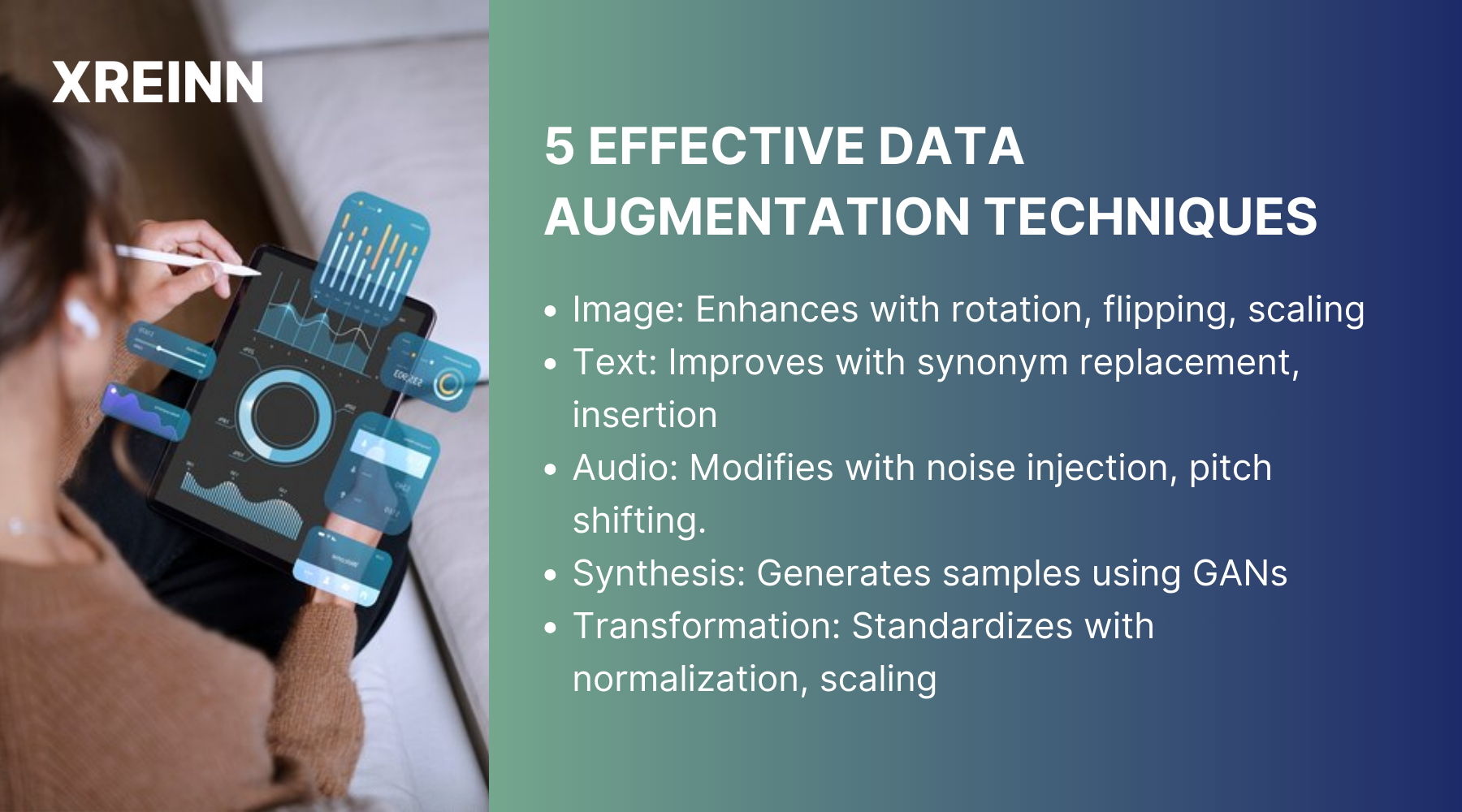Data Analytics
5 Effective Data Augmentation Techniques: Improve Your Data Analysis
Jul 08, 2024
In the business world, the ability to refine and improve your data can set you apart from the competition. Data augmentation offers an innovative approach for businesses struggling to maximize their data's potential. Making the best decisions is more important, and the quality and quantity of your data play a pivotal role in shaping those insights. This is where data augmentation becomes invaluable.
By improving and expanding your existing datasets, you can uncover deeper insights, improve the accuracy of your analyses, and ultimately make more informed decisions. For any business, using data augmentation techniques is not just advantageous—it is essential for maintaining a competitive edge. In this article, we will explore five effective data augmentation techniques that can significantly improve your data analysis efforts.
Understanding Data Augmentation
Data augmentation involves creating new data samples from the existing data, essentially increasing the dataset's size and diversity without collecting new data. This process can help overcome challenges like limited data availability and improve the validity of your data models. For SMEs, data augmentation can provide the much-needed edge in a competitive market by revealing insights that would otherwise remain hidden.
Traditional data analysis methods often fall short due to the limited scope of the data. Data augmentation, on the other hand, expands the dataset, allowing for more comprehensive analysis. By using various techniques to modify and improve the data, you can ensure that your data models are more accurate and reliable.
5 Effective Data Augmentation Techniques

1. Image Augmentation
Image augmentation is one of the most widely used data augmentation techniques, especially in fields like computer vision and machine learning. By applying various transformations to images, you can create multiple versions of the same image, thereby increasing the dataset size and diversity.
Common methods of image augmentation include rotation, flipping, scaling, cropping, and color variation. For instance, rotating an image by a few degrees can create a new version of the image that the data model treats as a distinct sample. Similarly, flipping an image horizontally or vertically, scaling it up or down, or adjusting its color balance can produce numerous variations.
Several tools can help you implement image augmentation, such as TensorFlow, Keras, and OpenCV. These tools provide built-in functions for various augmentation techniques, making it easier for you to enhance your image datasets.
In real-world applications, image augmentation can be used in industries like healthcare, where medical images need to be analyzed for diagnosis, or in retail, where product images need to be processed for visual search algorithms. For SMEs, using image augmentation can improve the accuracy of visual data analysis, leading to better product recommendations, improved customer experiences, and more accurate diagnostic tools.
2. Text Augmentation
Text augmentation is another powerful technique, especially useful in natural language processing (NLP) tasks. By augmenting text data, you can create a richer and more diverse dataset, improving the performance of NLP models.
Popular methods of text augmentation include synonym replacement, random insertion, random swap, and random deletion. For example, you can replace words in a sentence with their synonyms, insert random words, swap words around, or delete certain words to create different versions of the same text.
Tools like NLTK, SpaCy, and TextBlob offer functionalities to perform these text augmentation techniques. By using these tools, you can improve your text datasets, making them more robust and comprehensive.
Applications of text augmentation are vast, ranging from sentiment analysis and content creation to customer feedback analysis and chatbot training. For businesses, text augmentation can improve the accuracy of sentiment analysis, leading to a better understanding of customer feedback and more effective marketing strategies. Additionally, it can help generate distinct content, and improve SEO efforts, and the performance of chatbots and virtual assistants.
3. Audio Augmentation
Audio augmentation is essential for tasks involving speech recognition, music analysis, and customer service analytics. By modifying audio data, you can create new versions of the same audio clip, improving your dataset's size and variety.
Common techniques for audio augmentation include noise injection, pitch shifting, time stretching, and volume control. For instance, you can add background noise to an audio clip, change its pitch, stretch its duration, or adjust its volume to create different versions of the same clip.
Tools like Librosa and Audacity provide functionalities for these audio augmentation techniques. Using these tools, you can improve your audio datasets, making them more diverse and powerful.
In practical applications, audio augmentation can be used in speech recognition systems to improve accuracy by training the models on distinct audio samples. It can also be used in music analysis to create various versions of a song for better genre classification or mood detection.
4. Data Synthesis
Data synthesis involves generating new data samples that resemble the original data. This technique is particularly useful when you have limited data available. By creating synthetic data, you can fill gaps in your dataset and improve the performance of your data models.
Methods of data synthesis include synthetic data generation, Generative Adversarial Networks (GANs), and data simulation. For example, synthetic data generation involves creating new data points that mimic the characteristics of the original data. GANs use two neural networks to generate new data samples that are indistinguishable from the original data. Data simulation involves creating artificial data based on certain rules and patterns.
Tools like Synthpop, DataSynthesizer, and Gretel.ai offer functionalities for data synthesis. These tools can help you generate synthetic data, enhance your dataset, and improve your data models' performance.
Real-world applications of data synthesis include market research, where synthetic data can be used to simulate customer behaviors and preferences, financial forecasting, where synthetic data can help predict market trends, and healthcare, where synthetic patient data can be used for research and analysis. For SMEs, data synthesis can provide valuable insights by filling data gaps and improving the accuracy of data analysis.
5. Data Transformation
Data transformation involves modifying and standardizing data to make it suitable for analysis. This technique is important for data preprocessing, feature engineering, and model training.
Common methods of data transformation include normalization, standardization, data scaling, and encoding. For instance, normalization involves scaling data to a specific range, while standardization involves adjusting data to have a mean of zero and a standard deviation of one. Data scaling involves adjusting the data to a specific scale, and encoding involves converting categorical data into numerical values.
Tools like Pandas, and Scikit-learn provide functionalities for data transformation. These tools can help you preprocess your data, making it suitable for analysis and improving the performance of your data models.
Applications of data transformation include data preprocessing, where the data is cleaned and prepared for analysis, feature engineering, where new features are created from the existing data, and model training, where the data is used to train machine learning models.
Conclusion
Data augmentation is a powerful technique that can significantly improve your data analysis efforts. By using image augmentation, text augmentation, audio augmentation, data synthesis, and data transformation, you can create a richer and more distinct dataset, improving the accuracy and reliability of your data models.
For businesses, using these techniques can provide a competitive edge, leading to better insights, improved customer engagement, and more effective decision-making. Experiment with these techniques and see how they can transform your data analysis efforts.

Data Analytics
Jun 27, 2024Master key concepts in data analytics with practical tips to enhance decision-making and achieve success in your projects and professional growth

Data Analytics
Jul 01, 2024Learn the essential stages of the data analytics workflow to turn your data into valuable business insights and drive growth.

